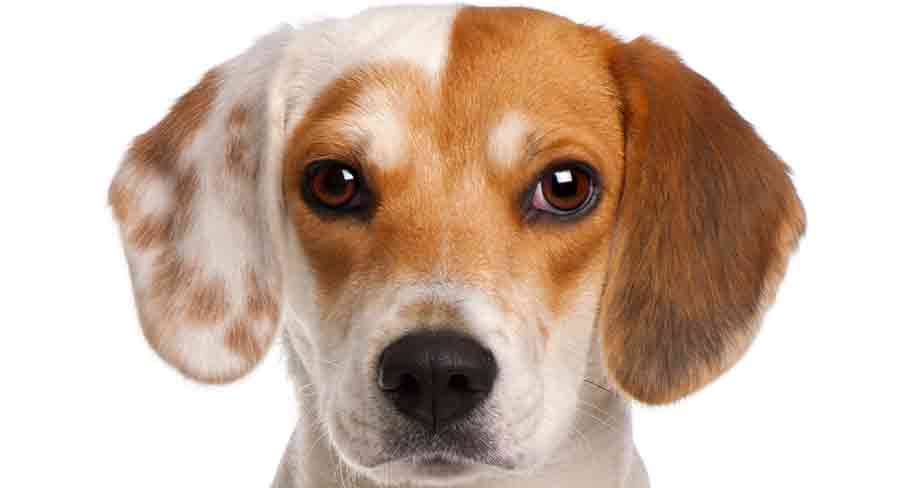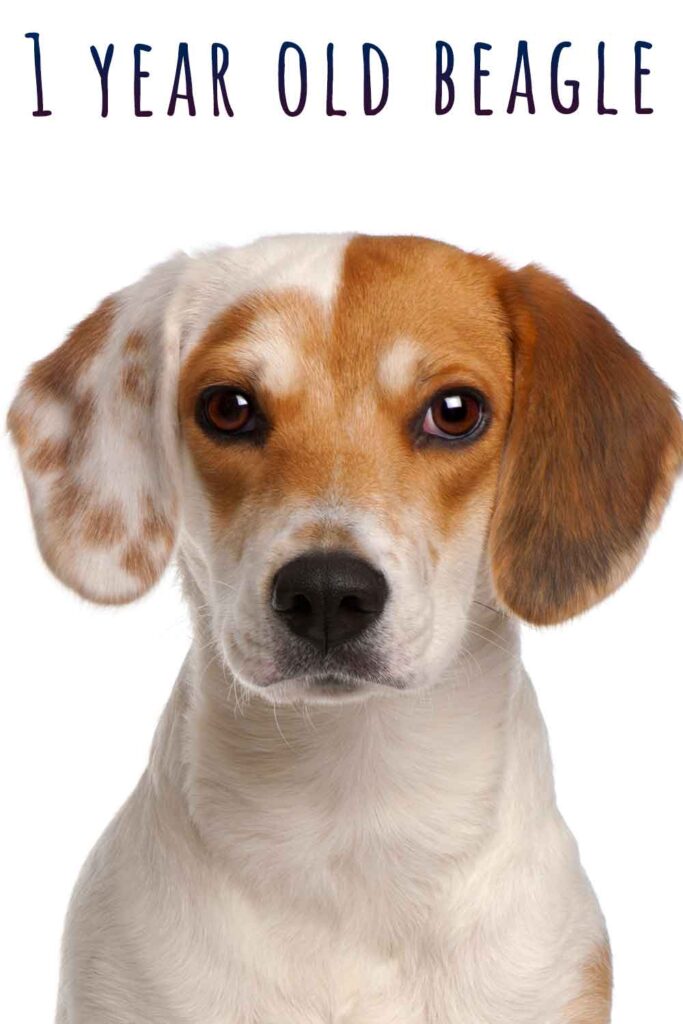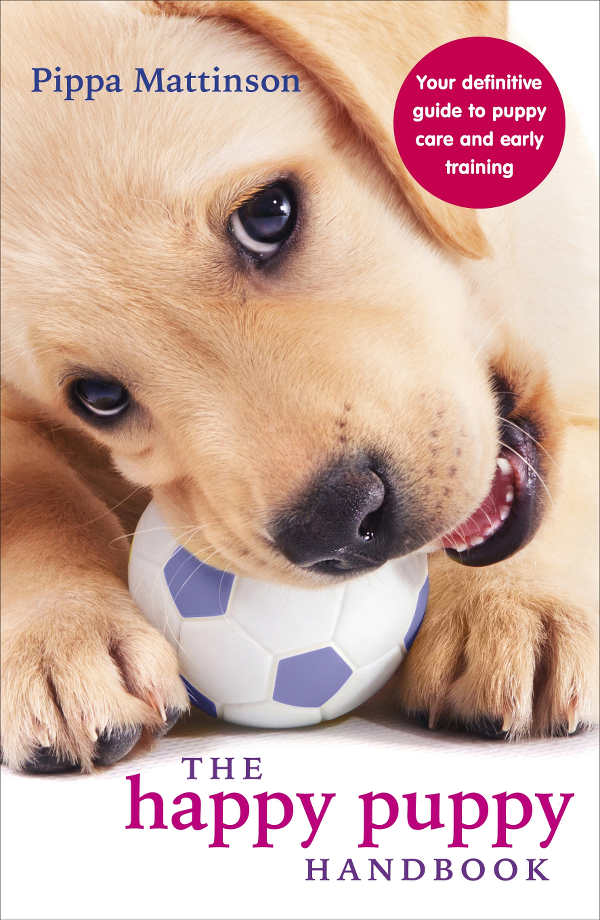
A 1 year old Beagle is still not quite fully grown, but they will be very close to their adult size. Whether you’ve adopted a 1 year old Beagle, or you’ve had them since 8 weeks old, you’ve still got a lot of exciting times to look forward to! At a year old, it’s likely you’ve already started some training, and have settled into a good routine with your Beagle. But, there are still plenty of common behavioral problems that can arise. Let’s take a closer look at what you can expect from a 1 year old Beagle, and how to stop any of those potential issues.
What to Expect From a 1 Year Old Beagle
A 1 year old Beagle will be much closer to their adult size, but this doesn’t mean they’ve reached full maturity in other areas. In fact, a 1 year old Beagle will still have lots of that playful, excitable puppy energy. So, regular exercise and mental stimulation through games and training will likely become a large part of your life from now on, if they already weren’t.
It’s natural to be concerned about whether your 1 year old Beagle is the right size, too. After all, you don’t want them to be overweight or underweight – both of which can lead to health problems. Since the question of Beagle size at 1 year old is so common, let’s get started by looking at Beagle development and size.
Is a 1 Year Old Beagle Fully Grown?
At 12 months, a Beagle won’t yet have reached their adult size. But, it’s likely they will be very close. The Beagle breed will usually reach their full size at around 1 and a half years old. So, over the next 6 months, you can expect your Beagle to finish growing.
The AKC accepts two ‘types’ of Beagle in terms of size. The smaller of the two will grow to be a maximum of 13 inches tall, weighing under 20 lbs. But, the larger of the two will grow to between 13 and 15 inches tall, weighing from 20 to 30 lbs. Both of these types tend to have a sturdy appearance. And, females tend to be slightly smaller than males.
You can use these measurements to gauge how close your Beagle is to their adult size. These measurements might also help you learn which variety of Beagle you have, if you didn’t already know from your breeder.
Is My 1 Year Old Beagle Still a Puppy?
As we now know, a Beagle isn’t fully grown at 12 months old. And, the same applies to their emotional maturity. At 12 months of age, most Beagles will still have their playful puppy energy, and will be keen to spend lots of time playing and exploring. You can consider your Beagle to be a maturing puppy, but not yet an adult.
Your 1 year old Beagle should be past their teething stage at this point. But, they will still be learning in other areas of their life. As long as you are consistent with training, your Beagle will be a well-adjusted and well-behaved member of the family. But, there may still be times where they have a sudden playful (and potentially destructive) burst of energy, or where a new undesirable behavior rears its head that you’ll want to fix, such as digging or pulling on the leash. We’ll cover those in a little more detail later. But, the main takeaway here is that patience and consistency in life with your Beagle and training are still key.

Is My 1 Year Old Beagle Underweight?
Since your Beagle should be nearing their adult weight at 12 months old, it can be a shock and a worry to find that they are still under the stats we mentioned earlier. But, this isn’t necessarily cause for concern. Remember, there are two varieties of the Beagle breed. And, the smaller of these varieties will be under 13 inches tall, weighing under 20 lbs as an adult. On top of this, female Beagles are often smaller than males, and there will be natural variation from one Beagle to the next.
Height and weight can be useful to know. But, there are some other ways to tell if your Beagle is underweight. One of which is easy and quick to do at home. You’re simply going to feel your Beagle and take a good look at them. You should be able to feel but not see your Beagle’s ribcage. If you can see your Beagle’s ribcage, it’s a good idea to take them to the veterinarian. They will be able to help you increase your Beagle’s weight in a healthy and safe timeframe, ensuring your still growing Beagle gets the right nutrients.
Is My 1 Year Old Beagle Overweight?
An equal concern for many Beagle owners is that their 12 month old pup is overweight. Especially when food is used as a training tool. You can test this out at home, using the same method before. If you can’t feel your Beagle’s ribs when you feel their sides, they may be overweight.
If so, take them to the vet for a proper examination. Your veterinarian will be able to help you implement a healthy diet and food plan to ensure your Beagle is still getting the right nutrients for healthy growth.
When training, you should stick to the proper daily calorie allowance for your Beagle’s age. So, subtract the food you use in training from that overall daily allowance. If you use kibble food at mealtimes, you can simply weigh out your Beagle’s meals at the start of the day, and take away the amount of kibble you need for training. In fact, some people feed their dogs entirely through training sessions through the day. But, if you’re at all concerned about the amount of food your Beagle is eating, or they still seem very hungry after their meals, the veterinarian is the best person to speak to.
How Much Exercise Does a 1 Year Old Beagle Need?
Studies have shown that too much exercise at a young age can contribute to health problems for our dogs. For instance, letting puppies use stairs before 3 months of age can increase their risk of developing joint issues like hip dysplasia. But, at 1 year old, it’s much safer for Beagles to exercise. In fact, most Beagle’s will have a lot of energy to burn at this age.
Some of that energy can be spent in training and games in the house. But, most 12 month old Beagles will also enjoy getting some exercise outside of the house. As a general rule, until your Beagle is fully grown (which is usually at around 18 months), you can give them 5 minutes of exercise per month of age, up to twice a day. So, for 1 year old Beagles, this means two exercise sessions a day of up to an hour. Which is quite a lot!
You can also adjust the type of exercise you’re giving your Beagle, if you are still concerned about their joints. Things like swimming, leash walking, and scent work are going to be kinder to your Beagle’s joints until they reach peak skeletal maturity. If you’re worried about your Beagle’s joints, you should speak to your veterinarian for more help.
How Much Sleep Does a 1 Year Old Beagle Need?
At 12 months old, your Beagle should be sleeping through the night. As long as you’re taking them out to the toilet before they go to sleep and are feeding them a few hours before bed. The exact amount of sleep that a 1 year old Beagle needs will vary from one dog to another.
Although your Beagle looks like an adult dog at this point, they are still growing and developing. So, they will still need a surprising amount of sleep. As well as a full night’s sleep, many 1 year old Beagles will need naps throughout the day. Especially as they are getting more exercise and plenty of mental stimulation through games and training. So, don’t be surprised if your Beagle is still getting around 16 to 18 hours sleep each day at this age.
Can I Train a 1 Year Old Beagle?
Despite the old saying, you can teach an old dog new tricks. And, at 12 months, your Beagle definitely isn’t old. So, if you’ve been putting off training, or have only just brought your Beagle home, you don’t need to panic. Training a 1 year old Beagle might be a little different to training a very young puppy, as it’s highly likely your Beagle will have learnt some unwanted behaviors and habits. But, it’s absolutely possible to train a 1 year old Beagle.
At 12 months, Beagles will also need plenty of mental stimulation, which can be achieved through training. And, training can offer some physical exercise on top of this. For more help and tips with training your 1 year old Beagle, take a look at the following links.
- Online Puppy Training
- The Three Ds Of Dog Training
- How to Use Your Dog’s Meals As a Training Aid
- Event Markers In Dog Training – What Are They And How Do They Work?
1 Year Old Beagle Behavioral Issues
At 12 months, you might think your Beagle is old enough to know better when they’re behaving badly. But, the fact is, a 1 year old Beagle is still a puppy. And, they are still learning. So, if you’ve noticed unwanted behaviors in your puppy, it’s not because your dog is trying to annoy you, or acting up for no reason. In fact, a lot of “naughty” puppy behaviors come from the same common roots.
Boredom
Beagles are intelligent dogs. But, the downside to that intelligence is the need for lots of stimulation. This can be through exercise, training, interactive toys, games, and more. If a Beagle is bored, they will often try to make their own fun. And this might not happen in ways that align with your ideas of how a dog should have fun. Instead of chewing on a toy, they might start digging at the carpet, or barking and howling at everything.
If you’ve noticed an increase in unwanted behaviors in your 1 year old Beagle, a great first step to tackle this is to reduce any potential boredom. Make sure your pup is getting enough exercise, and dedicate time each day to training and playing with your Beagle.
Lack of Training
It’s not uncommon for us to think our puppies are being naughty when they do something we don’t want, like peeing in the house or stealing socks and running off with them. But, a lack of training can be at the root of many of these issues. If you haven’t taken the time to potty train your Beagle, or to train them in obedience, you might find a 1 year old Beagle that still won’t drop things they shouldn’t have, or that jumps up at all of your guests!
If you’re noticing behavioral problems like this, it’s important to remember your Beagle isn’t necessarily being stubborn and naughty. For them, being chased around the house when you try to retrieve a sock is probably a very fun game. So, it’s important to work hard on training your Beagle, and stay consistent with this training, even at 1 year old.
Barking and Howling
Beagles are a naturally vocal breed. And some new Beagle owners might not have realised quite how much noise their puppies had the potential to make before bringing them home. There are some instances in which you can train a dog not to bark. But, for breeds like Beagles, who are naturally very vocal, this is something you may need to learn to accept. It’s not a sign that they’re being naughty.
In fact, barking and vocalisations can be your Beagle’s way of communicating with you. So, if you’ve noticed your Beagle barking more at 1 year old, consider whether they’re getting enough exercise and mental stimulation. Perhaps they are even needing to go out to the toilet more often than you think! Or, maybe they are hungry!
Pent Up Energy
It’s not uncommon for dogs to become destructive or noisy if they have a lot of pent up energy. Beagles are active dogs, and at 1 year old, they will be excited to get out and exercise. Some exercise can be achieved through training, but you will also need to dedicate at least 40 minutes a day to exercising your Beagle properly. If you’re worried about their joints, choose low impact options like swimming or scentwork.
Fear
As long as you socialized your Beagle well from a young age, fear based reactions shouldn’t be a problem. But, if your Beagle was adopted at a later age, or you didn’t get the chance to socialize them, you may notice fearful, or even aggressive, reactions towards things from your Beagle. Luckily, you can still socialize an older dog. But, it will be a slower process, and one that you will need to work hard at through your dog’s life.
Chewing and Biting
At 1 year old, a Beagle shouldn’t still be teething. Biting and nipping can be a result of rough play and overexcitement. But, it can also be a sign of a behavioral issue. So, it may be a good idea to speak to your vet or a behaviorist if you’re concerned about your 1 year old Beagle still biting.
Leash Pulling
Leash pulling is quite a rewarding behavior for our dogs, as they are getting where they want to go. So, it can be a hard habit to break. But, with consistent training and work, you can teach your Beagle to walk to heel, whether they are on a leash or not. It’s never too early or late for your Beagle to learn. Here are some links that can help you with this.
- Loose Leash Walking: An Expert Guide to Getting a Relaxing Stroll
- What to do When Your Dog Will NOT Stop Pulling on the Leash
Do You Have a 1 Year Old Beagle?
We would love to hear more about your 1 year old Beagles! Have you had them since they were 8 weeks, or have they only just joined your family? Make sure to tell us about your 12 month old Beagle in the comments.
References and Resources
- Siwak, C. (et al), ‘Effect of Age and Level of Cognitive Function on Spontaneous and Exploratory Behaviors in the Beagle Dog’, Learning Memory (2001)
- Krontveit, R. (et al), ‘Housing- and Exercise-Related Risk Factors Associated with the Development of Hip Dysplasia as Determined by Radiographic Evaluation in a Prospective Cohort of Newfoundlands, Labrador Retrievers, Leonbergers, and Irish Wolfhounds in Norway’, American Journal of Veterinary Research (2012)
- Farricelli, A. ‘Impact of Exercise on Puppy Growth Plates’, Daily Dog Discoveries (2017)
- Howell, T. (et al), ‘Puppy Parties and Beyond: The Role of Early Age Socialization Practices on Adult Dog Behavior’, Veterinary Medicine: Research and Reports (2015)
- Hiby, E. (et al), ‘Dog Training Methods: Their Use, Effectiveness and Interaction with Behavior and Welfare’, Animal Welfare (2004)
- Charmayne Bennett, P. & Ilse Rohlf, V. ‘Owner-Companion Dog Interactions: Relationships Between Demographic Variables, Potentially Problematic Behaviors, Training Engagement and Shared Activities’, Applied Animal Behavior Science (2007)
- Rehn, T. & Keeling, L. ‘The Effect of Time Left Alone on Dog Welfare’, Applied Animal Behavior Science (2011)

Danika Orlowski says
Thank you for providing this information. I’m going to try to train my year old beagle Milo to stop pulling on the leash during walks. I have had him since he was 8 weeks old, and he is just about 13 months now. Overall, he is a good dog but LOVES chasing rabbits, squirrels and birds (a true beagle!! Lol). I’ve been really lucky with him because he is not really a howler or barker. He usually saves that for outside or when I come home. Thanks again.
Jeff Carbine says
I never knew that too much activity at a young age has been linked to health issues in our pets, according to studies. I never thought that it would be like this, I’ll share this with my aunt. Thank you for the information about beagle puppies.